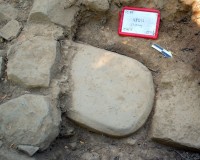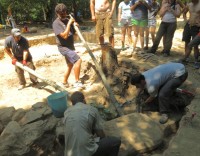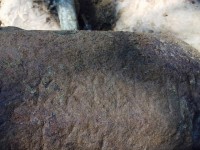 Archaeologists and students with the Mugello Valley Archaeological Project excavating the ancient Etruscan settlement of Poggio Colla about twenty miles northeast of Florence have discovered an ancient stele with a long inscription in Etruscan. Just days before the end of the dig, the team found an oddly shaped sandstone slab embedded in the foundations of a temple wall. When they first unearthed a section of the stone, they weren’t sure what it was. An unfinished column base or a recycled podium stand were suggested as possibilities, but when more of the slab was revealed, they saw the faint traces of an inscription and realized it was stele. It took the team several days of cautious excavation to find the inscription was an unusually long one, with multiple characters engraved along the edges of the stele.
Archaeologists and students with the Mugello Valley Archaeological Project excavating the ancient Etruscan settlement of Poggio Colla about twenty miles northeast of Florence have discovered an ancient stele with a long inscription in Etruscan. Just days before the end of the dig, the team found an oddly shaped sandstone slab embedded in the foundations of a temple wall. When they first unearthed a section of the stone, they weren’t sure what it was. An unfinished column base or a recycled podium stand were suggested as possibilities, but when more of the slab was revealed, they saw the faint traces of an inscription and realized it was stele. It took the team several days of cautious excavation to find the inscription was an unusually long one, with multiple characters engraved along the edges of the stele.
The slab weighs about 500 pounds and is almost four feet high and more than two feet wide. It dates to around the 6th century B.C. Archaeologists believe the stele was part of a sacred display in the first temple built on the site, an oval structure made of wood that bucchero pottery fragments date to after the early 7th century B.C. It was demolished around 2,500 years ago and new, larger temple was built with a stone podium and stone Tuscan Doric column bases. The old stele was reused as a foundation stone in the new temple.
 The news of the find quickly spread through the archaeological community of Tuscany. Two days after the stone was excavated, visiting Etruscan scholars watched as professional art and artifact movers recommended by the Tuscan Archaeological Superintendency lifted the stele from the site, strapped it to a sled and slowly lowered it down the wooded hillside to a waiting pickup truck. It was then transported to the laboratories of the Superintendency in Florence for conservation.
The news of the find quickly spread through the archaeological community of Tuscany. Two days after the stone was excavated, visiting Etruscan scholars watched as professional art and artifact movers recommended by the Tuscan Archaeological Superintendency lifted the stele from the site, strapped it to a sled and slowly lowered it down the wooded hillside to a waiting pickup truck. It was then transported to the laboratories of the Superintendency in Florence for conservation.
Conservators are photographing and laser scanning the stele to reveal the full details of the inscription. The sandstone has been worn and chipped away and one side has been reddened, probably by fire. It will have to be cleaned before experts have a chance of deciphering the inscription, but they have counted more than 75 characters (letters and punctuation marks), an unusually long text for an Etruscan stele.
 Etruscan is often described as a “lost” language, and while it’s true that there are no known living languages related to it, it’s not an untranslatable mystery. In fact, scholars know a fair amount about it from the approximately 13,000 inscriptions in the language that have been discovered. The known vocabulary is limited because most of those inscriptions are very short funerary texts found in tombs or “property of” lines on bronze mirrors.
Etruscan is often described as a “lost” language, and while it’s true that there are no known living languages related to it, it’s not an untranslatable mystery. In fact, scholars know a fair amount about it from the approximately 13,000 inscriptions in the language that have been discovered. The known vocabulary is limited because most of those inscriptions are very short funerary texts found in tombs or “property of” lines on bronze mirrors.
( I have to briefly digress to mention my favorite Etruscan inscription: the Liver of Piacenza, a bronze sculpture of a life-sized sheep’s liver that is divided into sections labeled with the name of the deity believed to inhabit that piece of the liver. It’s a sort of guide for the haruspex, a diviner who read omens and made predictions from the entrails of sacrificed animals.)
I have to briefly digress to mention my favorite Etruscan inscription: the Liver of Piacenza, a bronze sculpture of a life-sized sheep’s liver that is divided into sections labeled with the name of the deity believed to inhabit that piece of the liver. It’s a sort of guide for the haruspex, a diviner who read omens and made predictions from the entrails of sacrificed animals.)
The stele is not a funerary text. It’s a religious dedication from an early phase of the site. Its location adds to its rarity since most Etruscan inscriptions have been in what was once southern Etruria. Poggio Colla is in the northern Etruscan territory.
“We know how Etruscan grammar works, what’s a verb, what’s an object, some of the words,” Warden said. “But we hope this will reveal the name of the god or goddess that is worshiped at this site.” The text will be studied and published by a noted expert on the Etruscan language, Rex Wallace, Professor of Classics at the University of Massachusetts Amherst.[…]
It would be a rare discovery to identify the Etruscan god or goddess to which the sanctuary was dedicated.
“Apart from the famous seaside shrine at Pyrgi, with its inscribed gold plaques, very few Etruscan sanctuaries can be so conclusively identified,” [University of Pennsylvania Museum Etruscan scholar Jean MacIntosh] Turfa said. “A study of the names of the dedicants will yield rich data on a powerful society where the nobility, commoners and even freed slaves could offer public vows and gifts.”
A crib sheet for reading entrails. I love it.
Wow! I hadn’t heard about this–and I live in Florence and was in the Archeological Museum yesterday. That is where the stele will presumably end up–in a million years, after they get the thing figured out.
Edward, maybe the stele can be scanned and 3D-printed so a replica can be viewed in the Museum (and/or scanned and put online by tyhe Museum in a rotatable form so that many more can see it).
Alternatively, “Eat at Joe’s”
I want to recommend to all this online shop of etrurian art, I am the Florentine artiginai producing handmade replicas of statues and Etruscan sculptures Go and visit and let me know.